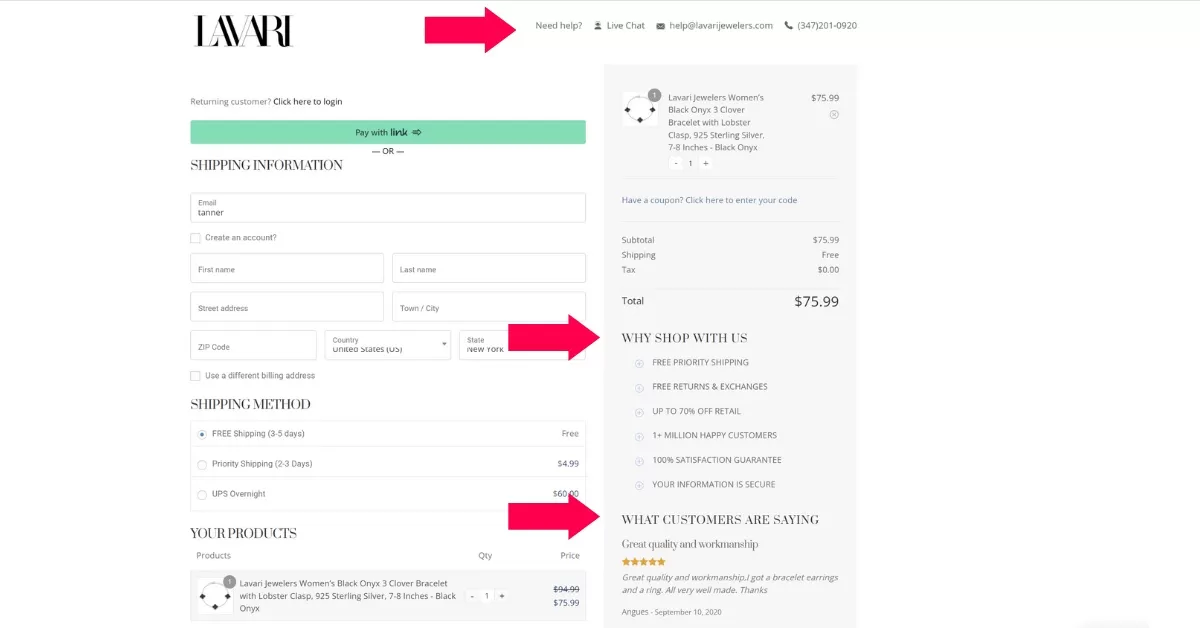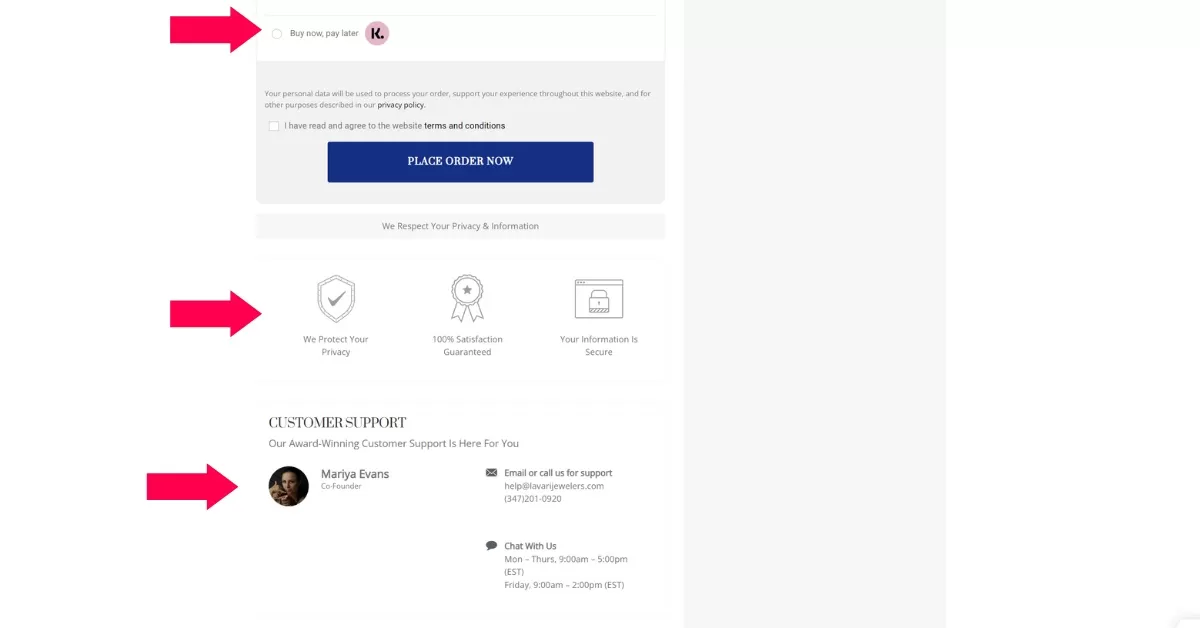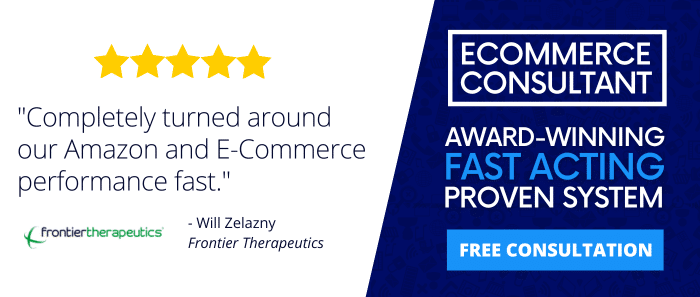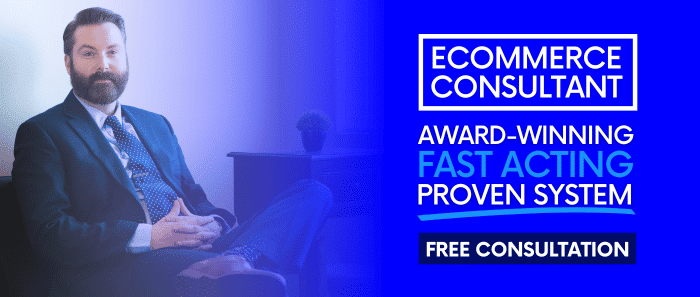The ONLY 2 Reasons Your eCommerce Site Isn’t Selling
The ONLY 2 Reasons Your eCommerce Website Isn’t Selling
Why is my eCommerce site not selling? Your online store isn’t selling because you have a traffic problem or a conversion problem.
If your online store has no sales, it’s because you’re either not getting the right traffic if any, OR you’re missing KEY elements from your website design.
If you have an eCommerce website with no sales, you will be able to fix your eCommerce website sales quickly & easily by following the tips in this article.
In over 10 years as a Fractional CMO, Amazon Consultant, and eCommerce Consultant, not to mention CEO, I’ve seen just about every mistake and the lessons from them. That means you get all the learnings without the scars.
Getting sales on your eCommerce website can be like vacuuming a beach.
Difficult & time-consuming.
Trust me, I would know, I run a top-rated and award-winning eCommerce Consultancy recognized by DesignRush who’s been at this 10+ years. I do this myself, selling on websites is not easy.
I have worked on/evaluated/audited /optimized hundreds of websites and I’m here to tell you that the issues of selling on websites boil down to 2 things.
I am going to break down what they are and more importantly, what you can do about it to increase your eCommerce website sales.

1) Not Getting Any or The Right Traffic
Seems like a good place to start right? Are people even coming to your eCommerce website?
Most eCommerce expert advice says, before you even start thinking about calculating conversion rates, you want to know if anyone is seeing your products to be able to buy them.
Here’s what to do:
- Go to Google Analytics 4
- Visits Reports
- Select Engagement, then Pages and Screens
This report will tell you what pages (or products) on your site people are viewing.
From here, you will have 3 scenarios.
1) People Aren’t Viewing Any Pages on Your Site
If you have no traffic or almost no traffic, you won’t be able to sell products.
How to fix it:
This is where you want to begin focusing on acquiring buyer intent, otherwise known as commercial traffic from sources like:
- SEO
- PPC
- Influencer Marketing
- Affiliate Programs
- Email Marketing
The important note here is Buyer Intent traffic.
You want to focus on driving people to your website that already know they want what you sell.
That means, they:
- Have the problem you solve
- Have the pain you alleviate
- Have the desire you fulfill
Then, they’ve already researched the best product and now want what you sell.
Here’s an example:
Buyer Intent: Plant Protein Powder, Vanilla, 30 Servings, Gluten Free
Research-Based: Protein Powder
- You can see with this research-based example, someone is searching for protein powder, but they clearly don’t know how much they need, what flavor or any diet restrictions it needs to meet.
Begin focusing on getting buyer-intent traffic to your website.
2) People Are Viewing Blog Posts, But Not Products
This means people are on your eCommerce website to read, not to buy.
How to fix it:
- Place call-to-action ads in your blog posts directing people to the products they’d most likely be interested in based on the topic of the blog post.
- Embed products into the blog posts themselves so the customer can add to the cart right from the blog post rather than having to navigate to a product page.
- Focus on getting buyer intent traffic to your product pages through:
- SEO
- PPC
- Influencer Marketing
- Affiliate Programs
- Email Marketing
3) People Are Viewing Products, But No Sales
You have a design problem as well as a traffic problem.
This means people don’t like what they see when they land and are entering the page via a traffic source that doesn’t imply they want to buy, they want to browse.
How to fix it:
- Head to Google Search Console
- Click on Performance
- Click on Pages in the Table Header
- Locate your product pages
- Click on one of the product pages
- Click on the Queries table header
These are the keywords bringing people to that product page from Google.
if you see mostly generic or research-based keywords, then you need to optimize your page for buyer-intent keywords.
Here is an infographic that outlines the path from a customer being unaware that they need what you sell to aware of your brand and your product and ready to buy.
Your next challenge is design.
Customers are viewing your products but they aren’t sure this is the right product for them nor the right place to buy the product.
The next section will tell you exactly what to do about that.

2) Design Elements Are Missing From Your Website
If your ecommerce website isn’t selling, customers are not finding what they are looking for and I do not mean products.
This is what customers are looking for.
S.A.F.E
Your homepage, product category, and sub-category pages as well as your product detail pages need to make it obvious and apparent how your product:
- Solves their problems
- Alleviates their pains
- Fulfills their desires
- Engages their emotions
All of your copy, imagery, and video must be aligned to achieve this.
Agitate Pain & Problem:
Your customers are either on your website with the intent to solve their problems or alleviate their pains, or they were interrupted and drawn to your website with intrigue.
Now is the time to get them across the finish line to buy by reminding them how inconvenient or painful their obstacles are.
Agitate the pain and problem through copy, text and imagery.
Highlight how not having their dream outcome costs them:
- Money
- Time
- Physical Pain
- Emotional Pain
- To Compromise Their Values
- Failure To Keep Up With The Jones’s
The Dream Outcome:
Also, your homepage, product category, and sub-category pages as well as your product detail pages need to show to the customer, the dream outcome of what they hope to achieve by purchasing your product.
This is also known as the idealistic self or aspirational self.
Customers don’t buy what your product is, they buy what it helps the customer become.
Proof of Efficacy:
Significant real estate on each of your pages should be devoted to proving to the customer that your product will achieve their dream outcome.
This can be:
- Reviews (Quantity & Quality)
- Testimonials
- Customers
- Professionals
- Video Evidence
- Before & After
- Awards
- Certifications
- Years of Experience
- Statistics, Facts & Figures
Social Proof:
Your customers do not want to feel alone, we all strive to be part of the tribe.
What’s more, we don’t want to feel like we are the first ones to “give this a try”.
That’s why, adding social proof is a must.
- Reviews
- Quantity and Quality
- Statistics, Facts & Figures of The Number of Happy Customers
- User Generated Content
- Testimonials
- Video
- Image
- Written
- Trusted By: (include notable customers or notable types of customers)
Credibility Indicators:
You need to prove to your shopper that you are the right brand with the right product to solve their problem, alleviate their pain, and fulfill their desire.
- Notable Media Coverage
- Prestigious Customers or Types of Customers
- Awards & Certifications
- Impressive Statistics, Facts, and Figures
Reduce Friction:
Your shoppers should have the easiest experience you can possibly provide.
This increases the likelihood they won’t leave to find an easier shopping experience elsewhere, where they may already have payment information saved, are assured 2-day shipping, etc.
To give your customers a frictionless shopping experience, make sure you offer:
- On-site Order Tracking
- All Payment Gateways
- Buy Now Pay Later
- Social Logins For Easy Account Creation & Returning Customers
- Free Shipping
- Fast Shipping
- Loyalty Reward Points Programs
- Cashback Provider Availability (Rakuten, TopCashBack, etc.)
Mitigate Risk:
Shoppers want to feel the peace of mind of knowing if they put money in, they can get money back out if something goes wrong.
- Money-Back Guarantees
- Try Before You Buy Programs
- Warranty Information
- Included Insurances
Virtue & Value Alignment:
Shoppers, particularly purpose-driven consumers need to know their virtues and values align with the brand they choose to support with their purchase.
- Made in the USA
- American Owned & Operated
- Small Business
- Family Owned
- Women Owned
- Minority Owned
- Diet Alignment
- Sustainability & Eco-Friendly
- Philanthropic Endeavors
- Brand Story
- Mission Statement
Peace of Mind:
If a shopper is going to feel comfortable enough to place an order on your site, they need the peace of mind of knowing they have someone to contact in case of a problem.
Not a chatbot, not an email address, a person, with a face, a name, and a phone number.
A phone number in the main navigation achieves this during your first impression.
But don’t stop there, at the bottom of every page, have a customer service pre-footer with:
- A profile photo
- The name of the person they can contact for customer service
- A phone number
- An email
- Hours of operation

This same principle will come back around later in the checkout.
The 16 Core Human Desires:
Ohio State Professor Steven Reiss distilled our core human desires to 16.
Even though you have 16 to work with, reduce the urge to address as many as possible, and focus on one per landing page.
While you’ll want to test through your ads and landing pages which core human desire performs best at facilitating sales, it’s easier for a shopper to focus on and align with one core human desire.
Here are the 16 core human desires to choose from.
1) Survival, Enjoyment of Life, Extension of Life:
To desire to survive as long as possible and to enjoy one’s life.
2) Enjoyment of Food & Beverages:
The desire to not only eat and drink but enjoy your food and beverages.
3) Freedom from Fear, Pain and Danger:
The desire to avoid pain, alleviate pain, and avoid dangerous situations by mitigating risk.
4) Sexual Companionship:
The desire for romance and sexual companionship.
5) Comfortable Living Conditions:
The desire to be comfortable in one’s dwelling.
6) To Be Superior, Winning & Keeping Up With The Joneses:
The desire to increase self-esteem through status and recognition.
7) Care and Protection of Loved Ones:
The need and desire to provide care and protect loved ones.
8) Social Approval:
The need and desire to belong and achieve validation for self-esteem.
9) To Be Informed:
The desire to be self-sufficient, achieve personal growth and intellectual stimulation.
10) Curiosity:
The desire to explore, learn, and understand the world around them.
11) Cleanliness of Body & Surroundings:
The desire for hygiene health, social acceptance, psychological well-being, and personal preference.
12) Efficiency:
The desire for resource optimization, productivity, cost-effectiveness, competition, innovation, and personal and professional goals.
13) Convenience:
The desire to save time, reduce effort, and simplify various aspects of life.
14) Dependability, Quality:
The desire for consistency, reliability, trust, customer satisfaction, and long-term relationships
15) Expression of Beauty & Style:
The desire for aesthetic pleasure, self-expression, cultural influences, personal enjoyment, and the communication of identity.
16) Economy, Profit & Bargains:
The desire to meet financial goals, achieve business success, and save on costs.
Frequently Asked Questions:
Not only does a FAQ benefit you with SEO and Ad robot crawlers, but having a FAQ also removes friction from the buying process.
Look up the questions that “people also ask” on Google and the Q&A section of Amazon to find out what people want to know about your products.
Then, make sure one appears all:
- Homepage
- Landing Pages
- Category & Sub-Category Pages
- Product Detail Pages
The 2 Orientation Questions:
When a customer lands on your eCommerce website, in order to orient and commit, they need to know 2 things.
- Is this the right product for me?
- Is this the right place to buy the product?
If your eCommerce website isn’t selling, you aren’t answering these questions.
You are trying to convince the customer that what you sell is right for them but also that they shouldn’t go buy it on Amazon or elsewhere where they already have payment information saved, a 2-day shipping promise and significant brand trust.
How to fix it:
We’re going to look at the 3 main touch points in the funnel you have on your eCommerce website to make a sale or lose a sale.
Home, Category & Landing Pages:

Your main goal of these pages is to get potential customers to stay on the page and not hit the back button, then make it simple for them to get to the product they want to find.
To prevent a potential customer from bouncing, we will focus on answering the two questions the customer is asking before they have to scroll down beneath the fold:
- Are these the right products for me?
- Is this the right place to buy the product?
The right product for the customer:
- Headline explaining what you’re selling.
- Sub-Headline elaborating on your unique value proposition.
- The imagery of the product or the happy result of using your product.
The right place to buy the product:
- Your seller ratings
- A phone number to call if a customer has issues
- Chat support for if the customer has issues
- Order tracking to put the customers mind at ease
- As seen on major media publications for social proof and increased perceived value
- Trust & Credibility Badges such as:
- Free Shipping
- Free Returns
- Buy Now Pay Later
- X Number of Years in Business
- Made in the USA
- USA Based
- Satisfaction Guarantees
- Secure Shopping
You want to show the customer what life is like after using your product.
Product Page:

When you run Google Shopping Ads, Email Campaigns, Social Media Ads & more, you send your buyer intent traffic to individual product pages.
When they land, this is their first interaction with your site, which means they haven’t seen your homepage, about page, or FAQ pages and know nothing about your company, let alone your product.
That means you need to reinforce why they need you shop with you specifically as well as why this is the right product for them before they have to scroll down.
The right product for the customer:
- Product Hero Image & Gallery
- Product Title
- Price
- Key Badges or Iconography That Represents Key Characteristics
The right place to buy the product:
- Your seller ratings
- A phone number to call if a customer has issues
- Chat support if the customer has issues
- Order tracking to put the customers’ mind at ease
- As seen in major media publications for social proof and increased perceived value
- Trust & Credibility Badges such as:
- Free Shipping
- Free Returns
- Buy Now Pay Later
- X Number of Years in Business
- Made in the USA
- USA Based
- Satisfaction Guarantees
- Secure Shopping
It doesn’t stop there though.
Once the customer clicks add to cart, you don’t want to lose them.
You want to instruct them to take the next step: check out.

The last thing you want the customer to do is add a product to cart, get distracted, leave and then not check out.
If your eCommerce website isn’t selling, you’re likely not getting the customer across the finish line.
You want to present them with a pop-up after they click add to cart or order now that makes it clear their next step is to check out and invites them to do so.
Speaking of the checkout, if you’ve left your checkout the way it came from Woocommerce, Shopify, Bigcommerce or another eCommerce CMS that you’re using, you’ve made a big mistake.
Checkout Page:
Your checkout page is where you seal the deal.
It’s also where the most abandonment of a site happens.
That’s why you need to optimize your checkout page to make the customer:
- Trust you
- Feel Secure
- Want to complete their purchase
Here’s how to optimize your checkout page:

- Remove distractions by eliminating your main navigation.
- Show an email address and phone number to make the customer feel comfortable.
- Remind the customer why they should shop with you specifically and not go elsewhere.
- Showcase customer testimonials for social proof.

- Let the customer buy now and pay later.
- Showcase trust badges such as Secure Shopping, Warranties, Guarantees, etc. near where you ask them to complete the checkout.
- Show a face, name and contact information for customer service so the potential customer feels confident that if anything goes wrong, they know exactly who to contact and how.
Helpful Resources for eCommerce Website Sales:
- Is your site sending all the right color psychology signals to your users to inspire them to take action and make a purchase?
- This article: The Psychology of Color in eCommerce breaks down really well the different colors and how they affect how your visitors to your online store feel, think, etc.
- The error I see the most is you want to make all the colors, especially on the buttons the same color as your branding because “it looks pretty” or “sleek” or “elegant” but whoa… you may actually be telling someone to take a hard pass on what you’re selling.
- Is your sales copy aligned with their needs?
- We used the example earlier about speaking directly to the target customer.
- You want to use the words they use, focus on benefits over features, etc.
- The Moz blog has a great article with 4 Ways Copywriting Can Boost Your Conversion Rates.
- If you need help with what questions to ask to get inside the mind of your consumer, you could consider working with one of the top consulting agencies.
- Is the layout of your site aligned with the data that tells you how users read eCommerce sites and the hierarchy of importance, what they read first, what they tend to skim through, etc.?
- Over on Neil Patel’s blog, he has a great article about What these 9 Timeless Conversion Studies Can Teach You About 10x-ing Revenue
- Using an out-of-the-box template can be detriment to your conversion rates and a Custom Web Design is critical to sales.
- If you need help with this, you would look into eCommerce development companies that specialize in Conversion Rate Optimization.
By the way, marketing in Amazon & eCommerce is complex, with lots of challenges that cost you time & money.
If you want to sell more and spend less, I’m a top-rated Fractional CMO, Amazon Consultant & eCommerce Consultant with 10+ years of Fractional CMO Services, Amazon Consulting & eCommerce Consulting experience, and come with a proven, one-of-a-kind system to drive sales.
Whether it’s consulting Amazon brands, working with great companies at my Fractional CMO Agency or helping grow eCommerce website sales at my eCommerce Consultancy I can help you sell more & spend less.
Get a quick free consultation.









